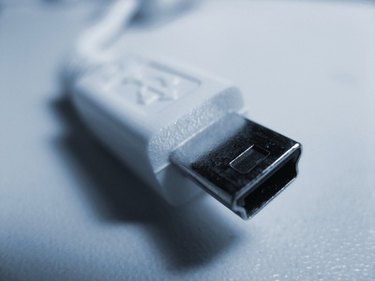
If you've wondered whether USB Plus and USB 2 are competing technologies, the answer is no. In fact, the two are not directly comparable. USB 2.0 is a successor to the old USB 1.1, and is often called "USB" without mentioning the "2.0." In contrast, "USB Plus" is short for "USB Plus Power," which refers to the fact that a USB Plus Power port is bigger than a standard USB port because it includes an extra connection for more power.
USB Background
Video of the Day
"USB" stands for "Universal Serial Bus." It is an industry standard interface for connecting peripheral devices, such as cameras and keyboards to a "host controller," which can be anything from a personal computer to a personal digital assistant. It was invented in 1996 at Intel as an alternative to serial and parallel ports. The key appeal of USB is that, in most cases, you can plug a USB device into, say, your computer, and it will immediately work—leading to the marketing slogans "hotplugging" and "plug and play." This means installation is quick, no reboot is required and there is no danger to the computer hardware posed by connecting a USB device while the system is active.
Video of the Day
USB Power
The USB interface carries not just data between the device and the host, but operating power to the device as well. This conveniently allows USB devices to function without being plugged in separately to an electrical outlet. However, the amount of power available is low, providing 5 volts and less than 1 amp. Consequently, USB devices must operate on low power or have a second power source, which is a significant constraint.
USB 2.0
USB 2.0 was released in 2000. It increased data bandwidth from the old USB 1.1 specification of 1.5 megabits per second to 480 megabits per second—a theoretical performance increase of over 3000 percent. This higher bandwidth enabled larger data transfers, which made USB feasible as an interface for data storage devices such as external hard drives.
As of 2010, almost all USB ports you are likely to see are USB 2.0 ports. This will change over time, however, as USB 3.0 was released in 2010.
USB Plus Power
USB Plus Power is a proprietary offshoot of the USB architecture, and is owned by IBM. The technology is much less widely used, and you are not likely to see it in consumer products. Instead, USB Plus Power is mostly used in commerce, for devices such as bar code scanners.
USB Plus Power is not endorsed by the USB Implementers Forum. In addition, as the hardware is proprietary, IBM charges a licensing fee for its use.
Comparison Between USB 2.0 and USB Plus Power
Both technologies use the same data transfer specifications. Only the power capacity differs.
The power specifications in USB 2.0 are similar to those of USB 1.1. Each USB port in USB 2.0 is rated for 5 unit loads of 100 milliamps apiece, for a total of exactly half an amp. Thus, devices using the USB 2.0 interface for their operating power often consume less than a single watt, and never more than 5 watts.
In comparison, USB Plus Power offers power at 5 volts, 12 volts, or 24 volts, and carries up to 6 amps. This enables devices to run at a much higher wattage.
Ordinary USB devices can usually be plugged into the standard connection part of a USB Plus Power port, provided they are compatible with the host controller. The reverse is not true: Devices with the larger plug will not fit into a standard USB port.